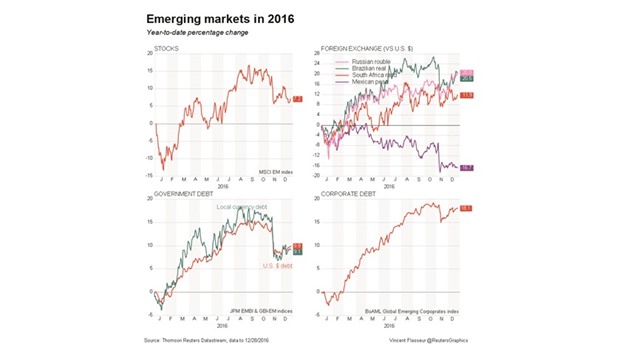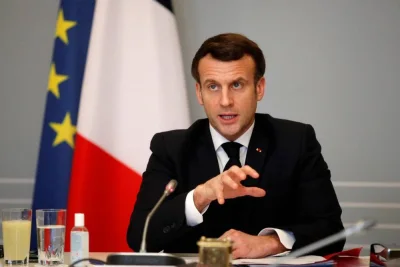Remarkable turnarounds in Brazil and Russia in 2016 gave many emerging market assets their first year of positive returns since 2012, on the back of a bounce in oil and commodity prices.
Although some of the gains have been capped by Donald Trump’s US election win, Brazilian stocks rose almost 60% in dollar terms, to be the best performing major equity market, while the real gained 20%, racing neck-and-neck with the rouble for the top currency spot.
While MSCI’s closely followed 23-country index of emerging market equities is up more than 7%, the commodity rebound, has meant Latin America, especially Peru and Colombia, have done particularly well.
Hungarian stocks have been eastern Europe’s best performers for a third successive year and Thailand topped Asia with an 18-percent rise.
On dollar bond markets, default-threatened Venezuela returned 52%, outdoing 9% gains on the underlying sovereign debt index.
“We have seen the recovery in commodity prices, the understanding that China can take pretty aggressive steps to stimulate growth in whichever way it feels is appropriate and we have a had a very accommodative global rates environment,” Aberdeen Asset Management investment manager Andrew Stanners said.
“Even the most vulnerable credits like Venezuela that have been hanging on by their fingernails have been able to find enough room to survive.”
Sovereign debt in emerging and hard currencies has delivered returns of more than 9%, versus zero on US Treasuries.
Emerging market corporate debt has done even better, returning almost 18%.
The recovery has been all the more surprising, given emerging markets’ worst-ever start to the year in January, when oil prices hit 12-year lows and fears flared that China was heading for a currency crisis.
Some of those worries remain: the yuan has fallen almost 7% against the dollar for its worst year since 1994, and Chinese mainland shares — star performers last year — have lost 18%.
But by spring, most emerging markets appeared to have shrugged off that rocky January.
And then came Donald Trump.
Mexico’s peso, already struggling due to domestic worries, was pounded by Trump’s ascent and eventual election win based on campaign threats to scrap trade deals and build a wall on the US-Mexican border to cut immigration.
The peso’s post-election drop has been just over 10%.
That has taken it almost 17% lower for the year, though the Turkish lira, hammered by doubts over monetary policy credibility and instability, has matched those falls. Since November, MSCI’s emerging equity index has lost more than 6%, versus 6-percent gains for the US S&P 500, while sovereign emerging dollar debt has lost 4%.
“It was all looking so good until November 8 and then everything changed,” Rabobank’s emerging market strategist Piotr Matys said.
On the bright side, “Trumponomics” — as the president-elect’s plans to reflate the economy have been dubbed — may not be entirely negative for emerging markets.
Commodity producers such as Russia and South Africa are likely to benefit.
Investors are betting some recent losers such as Mexico could stage a comeback in 2017 as bargain hunters step in.
“We should not be surprised if some key emerging market currencies appreciate from here,” fund manager Amundi’s head of macroeconomics, Didier Borowski, said.
“The Korean won, Mexican peso, the Taiwanese dollar, the Turkish lira, they are clearly undervalued.”

BRAZIL


